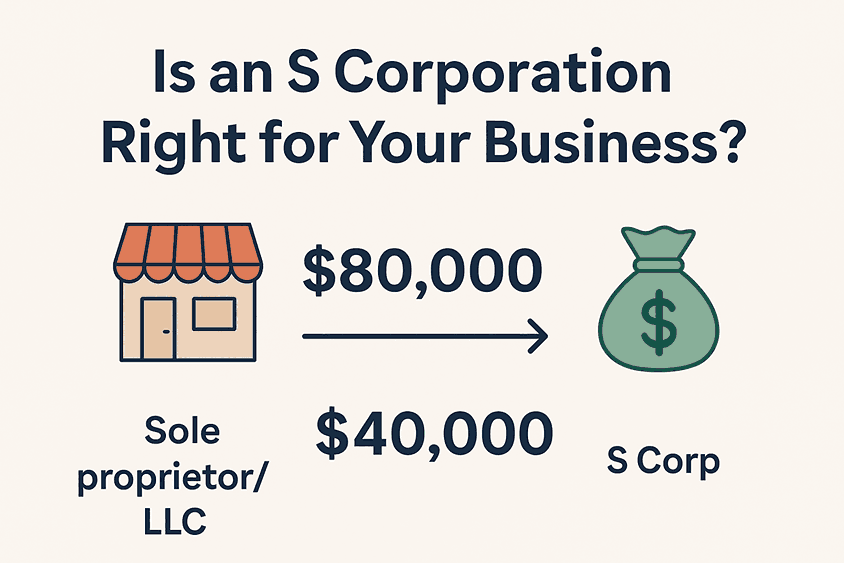
As a small business owner, you’re always looking for ways to maximize profits and protect your hard-earned assets. You’ve likely heard about the S Corporation (S Corp) as a popular tax strategy, but the question remains: when is the right time to make the switch?
The short answer is: when your business profits consistently exceed a certain threshold—typically starting around $40,000 to $60,000 in annual net profit. At this point, the potential tax savings can significantly outweigh the added administrative costs.
This article will break down the key benefits, considerations, and, most importantly, provide clear examples with data to show you how an S Corp can impact your bottom line.
The Core Benefit: Slashing Self-Employment Taxes
For sole proprietors or single-member LLCs, all business profits are subject to self-employment tax (currently 15.3%) which covers Social Security and Medicare. This is on top of your regular income tax.
An S Corp changes the game by allowing you to wear two hats: owner and employee. This distinction is the source of the tax savings:
- Reasonable Salary: You must pay yourself a “reasonable salary” as an employee of the company. This salary is subject to payroll taxes (the same 15.3% self-employment tax, but now split between the company and you).
- Profit Distributions: The remaining profit can be distributed to you as a shareholder. These distributions are not subject to the 15.3% self-employment tax. They are only subject to income tax.
Let’s see how this works in practice.
Example 1: Sarah the Consultant ($80,000 Profit)
Sarah runs a successful consulting business as a sole proprietor (LLC). Her business nets a profit of $80,000 for the year.
Scenario A: Staying as a Sole Proprietor (LLC)
- Total Net Profit: $80,000
- Self-Employment Tax: $80,000 x 15.3% = $12,240
- She then pays federal/state income tax on the remaining amount.
Scenario B: Electing S Corp Status
- Total Net Profit: $80,000
- Step 1: Pay a “Reasonable Salary.” After research, Sarah determines a fair salary for her role is $50,000.
- Payroll Tax on Salary: $50,000 x 15.3% = $7,650
- Step 2: Distribute Remaining Profit. $80,000 – $50,000 = $30,000.
- Tax on Distribution: This $30,000 is not subject to self-employment tax. It is only subject to income tax.
- Total Self-Employment/Payroll Tax: $7,650
The Bottom Line for Sarah
By electing S Corp status, Sarah saves $4,590 ($12,240 – $7,650) in taxes for the year. This saving must then be weighed against the additional costs of running an S Corp (payroll service, more complex tax filing), which might be around $1,000 – $2,500 annually. Even after these costs, she is still significantly ahead.
Example 2: Mark & David’s Design Firm ($200,000 Profit)
Mark and David are 50/50 partners in an LLC. Their business is thriving, with a net profit of $200,000 ($100,000 each).
Scenario A: Remaining a Partnership (LLC)
- Profit per Owner: $100,000
- Self-Employment Tax per Owner: $100,000 x 15.3% = $15,300
- Total SE Tax Paid by Both: $30,600
Scenario B: Electing S Corp Status
- Total Net Profit: $200,000
- Step 1: Pay Reasonable Salaries. They each pay themselves a reasonable salary of $60,000.
- Payroll Tax on Salary (per owner): $60,000 x 15.3% = $9,180
- Total Payroll Tax: $9,180 x 2 = $18,360
- Step 2: Distribute Remaining Profit. $200,000 – $120,000 ($60k x 2) = $80,000.
- This $80,000 is distributed equally ($40,000 each) and is not subject to self-employment tax.
- Total Self-Employment/Payroll Tax: $18,360
The Bottom Line for Mark & David
The S Corp election saves them a combined $12,240 ($30,600 – $18,360) in taxes annually. The administrative costs are a minor factor relative to this substantial saving.
Key Benefits Beyond Tax Savings
While the tax advantage is primary, S Corps offer other important benefits:
- Personal Asset Protection: Like an LLC, an S Corp is a separate legal entity. Your personal assets (home, car, savings) are protected from business debts and lawsuits.
- Pass-Through Taxation: Profits and losses are passed directly to your personal tax return, avoiding the “double taxation” of a C Corp (where the corporation is taxed, and then dividends are taxed again).
- Tax-Deductible Benefits: The company can offer benefits like health insurance, which can be tax-deductible for the business and tax-free for you as an employee.
Key Considerations & Eligibility
An S Corp isn’t for everyone. Before electing, ensure your business meets these criteria and you’re prepared for the responsibilities:
- Eligibility Rules: No more than 100 shareholders; all must be U.S. citizens/residents; only one class of stock.
- Administrative Burden: You must run formal payroll, file annual tax returns (Form 1120-S), and adhere to corporate formalities like keeping meeting minutes.
- “Reasonable Salary” Scrutiny: The IRS pays close attention to S Corp salaries to ensure owners aren’t avoiding payroll taxes by taking an artificially low salary. Your salary must be commensurate with what someone else would be paid for the same work.
The Verdict: When to Make the Move
Consider an S Corp election if:
- Your business has consistent, reliable profits exceeding approximately $60,000 (or even $40,000 depending on your situation).
- The projected tax savings outweigh the annual administrative costs.
- You have the cash flow to support paying yourself a regular, reasonable salary.
- You do not plan on seeking investment from venture capital firms (which often require preferred stock, not allowed in S Corps).
Crucial First Step: Consult a Professional
The examples above are simplified. Your specific tax situation, state laws, and what constitutes a “reasonable salary” for your industry are critical factors. It is highly recommended to consult with an accountant or tax advisor. They can run a detailed analysis to confirm if and when an S Corp election is the right strategic move for your growing business.
By understanding the numbers and the requirements, you can make a confident decision that protects your assets and keeps more money in your pocket.
